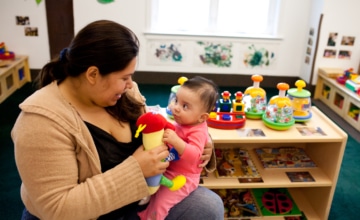In crisis and in calm, America’s future needs paid family and medical leave.
The COVID-19 pandemic brought our country’s caregiving crisis into sharp relief. In the absence of a national paid leave policy, many families were forced to put their economic security at risk as they took time from work to care for their families. Acknowledging this pressing need, Congress created emergency and temporary paid family and medical leave through the Families First Coronavirus Response Act. Without a permanent national policy, however, millions of families remain vulnerable to personal and public health crises that require them to choose between the income that sustains their families and caring for themselves or their loved ones.
For families with young children, the time right after a baby is born or adopted is a time of extraordinary growth, development, and connection. These early days and weeks are a time for parents to attend not only to physical needs – immunizations, breastfeeding and nutrition, and adjusting to a new schedule – but to build the crucial relationships that will help their babies thrive. Babies’ earliest relationships literally shape the architecture of their developing brains, forming the foundation for their futures. Positive, consistent relationships during babies’ earliest days result in individuals who are better equipped for success in school and life—paving the way for bigger returns down the road, including a higher-quality workforce and strong economic growth. These relationships may seem basic, but they require care, consistency, and above all, time.
While the Family and Medical Leave Act of 1993 provides important protections that have improved conditions for many families, too many American workers are not covered or cannot afford to take the unpaid leave it provides. Further, the majority of working parents do not have access to paid family or medical leave through their employers. The paid leave crisis is particularly marked for families of color, who overall have less access to paid leave and fewer financial resources to allow them to take leave, even when paid a percentage of their wages. If we want working families to succeed and boost our country’s economic stability, Congress and the Administration must commit to creating a permanent national paid family and medical leave program that ensures all families can provide their babies with the care and stability necessary for a strong future.
Quick Facts
- 85% of working people in the United States do not have access to paid family leave through their employers.
- A 10-week extension in paid leave reduced the death rate in children from one to 12 months old by 6%.
- Fathers who take two or more weeks off after the birth of a child are more involved in their infants’ care than fathers who take no leave.
- Children whose families have paid family leave have higher rates of immunizations and participation in well-child check-ups.
- Workers in low-wage jobs are less likely to have paid family and medical leave.
- Employers who have been affected by California’s paid family leave requirements reported that the program had a neutral or positive effect on business.
- 8 in 10 voters support a comprehensive national paid family and medical leave policy that covers all people who work.
Policy Recommendations
Create a national paid family and medical leave program.
While some states and localities have taken the lead in adopting paid leave policies, the time parents have to bond with and care for their babies should not be dependent on income, workplace, zip code, or gender. The Administration and Congress should create a comprehensive national paid family and medical leave insurance program, such as the Family and Medical Insurance Leave Act, that embodies the following core principles:
- Accessibility for all working people;
- A meaningful length of leave—at least 12 weeks;
- Coverage for the full range of medical and family caregiving needs established in the Family and Medical Leave Act;
- Affordability and cost-effectiveness for workers, employers, and the government;
- Inclusivity in its definition of “family”; and
- Protection from employer retaliation for workers who take leave.
Research
A period of paid leave after the birth of a child contributes to the healthy development of infants and toddlers.
- A child’s first relationships lay the foundation upon which future learning and relationships are built. Positive, consistent relationships during this period yield confident individuals who are better equipped for success in school and in life. Adequate time off from work gives parents and children the time that is necessary to make these connections, and their ability to do so sets the course for all future development.
- Paid leave yields higher rates and longer periods of breastfeeding, which reduces the rates of childhood infections and decreases maternal stress.
- Dedicated time at home with newborns, infants, and toddlers gives parents time to attend well-child medical visits and ensure that their children receive all necessary immunizations. These practices lower infant mortality and reduce the occurrence and length of childhood illnesses, which in turn reduce private and public health expenditures.
Paid leave improves outcomes for the entire family, including parents and caregivers.
- Paid leave is associated with health benefits for new mothers, including declines in depressive symptoms and improvement in overall health.
- Families in Rhode Island using the state paid leave program were much more likely to report better health, lower stress, and a higher satisfaction in their ability to care for their new children and arrange child care.
- Paid leave may also help prevent child maltreatment, perhaps by reducing risk factors like parental stress and depression.
The lack of a national paid leave policy disproportionately impacts Black and Latino families.
- Overall, families of color are less likely to have access to paid leave, and, on average, have fewer financial assets to weather gaps in income to take leave even when paid a percentage of their wages.
- Maternal mortality among Black women (40.8 per 100,000 live births) is more than three times higher than among white women (13.2 per 100,000 live births). Returning to work early interferes with the rest and follow-up medical care recommended for new mothers.
- Infant mortality for Black babies (11.1 per thousand births) is almost twice the national average (5.8 per thousand births). Paid leave is shown to decrease infant mortality.
Paid leave policies benefit employers, taxpayers, and the economy, now and in the future.
- After instituting paid leave in California, companies and organizations overwhelmingly reported that the policy had a neutral or positive effect on their businesses.
- As workers have support in growing their families, they develop loyalty to their employers. Furthermore, they get the early care for their children that can prevent issues like infant mortality and longer term illnesses that pull them away from work.
- Positive, consistent relationships during a child’s early years yield confident individuals who are better equipped for success in school and life, paving the way for a higher quality workforce and strong economic growth.
For additional information, see The Child Development Case for a National Paid Family and Medical Leave Program.
References:
Download the PDF of this fact sheet for a complete list of references and sources.




